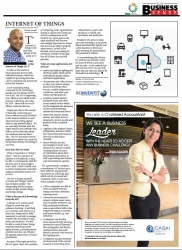Vindosh Sewpaul - Internet of things2016-12-05 The Internet of things is the new buzzphrase in the world of IT.
What is this Internet of Things (IoT)? It refers to the world of interconnected devices with embedded sensors, which are capable of providing data that can be controlled and monitored across the Internet. Is IoT something being conceived by the technology pundits for the distant future? Not at all, The IoT is happening now, albeit at very subtle levels, however it has been cited that by 2020 - there will be over 26 billion connected devices. Simply put, this is the concept of basically connecting any device with an on and off switch to the Internet (and/or to each other) and providing digital vitals to any physical object. We are currently familiar with the Apple watches and Jawbone that deliver us live time data about our workouts and our heart rate. The IoT has many various applications which can extend to incorporate almost everything in our lives. How does the IoT work? What is required is a “Thingâ€/ object: That you can give an identity to (IP address), it must be able to communicate with the internet, give it senses (sight / hear / taste / touch / smell), and it can be reached and controlled using an embedded sensor in it or on it. The IoT is a giant network of connected “things†(which also includes people). The relationship will be between people-people, people-things, and things-things. What is the practical knowledge from the IoT? It allows us to connect with things in a new way and enhances learning. It will help us to monitor and observe (e.g. heart rate, temperature, baby monitors) It can help to manage systems like tracking of traffic, safety and security). We will be able to control many things remotely (switching on/off lights at home, activating alarm systems) and also can enhance the gaming experiences of future generations. Because of the rapid growth in the IoT space, there are a number of competing tools, organisations hoping to define how connected devices communicate in the modern era. Open source and open standards will become increasingly important to ensure that devices are able to properly interconnect, as well as for the back end of processing the enormous volumes of big data that all of these devices will generate. What are some applications IoT devices?
Some examples include:
As overwhelming this all may be, with its vast benefits comes the fears of privacy and safety and security. As we embark into this new era of IoT, we can only hope that our fears are allayed by the leaders in technology. ï® Mobile: +27 83 435 0469 E-mail: vsewpaul@reinventit.co.za Website: www.reinventit.co.za |
Vindosh Sewpaul - Internet of things
Copyright © 2024 KwaZulu-Natal Top Business
